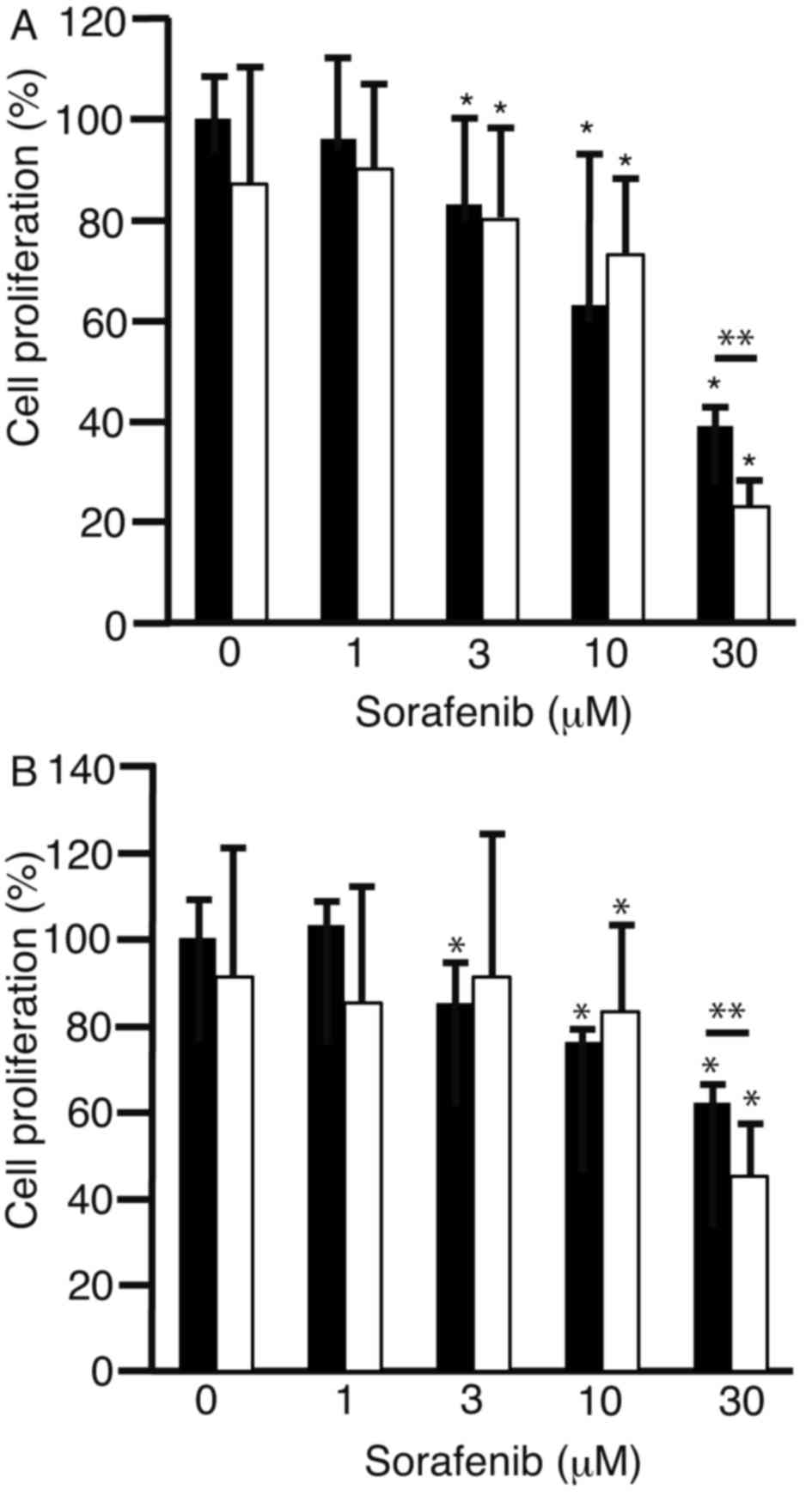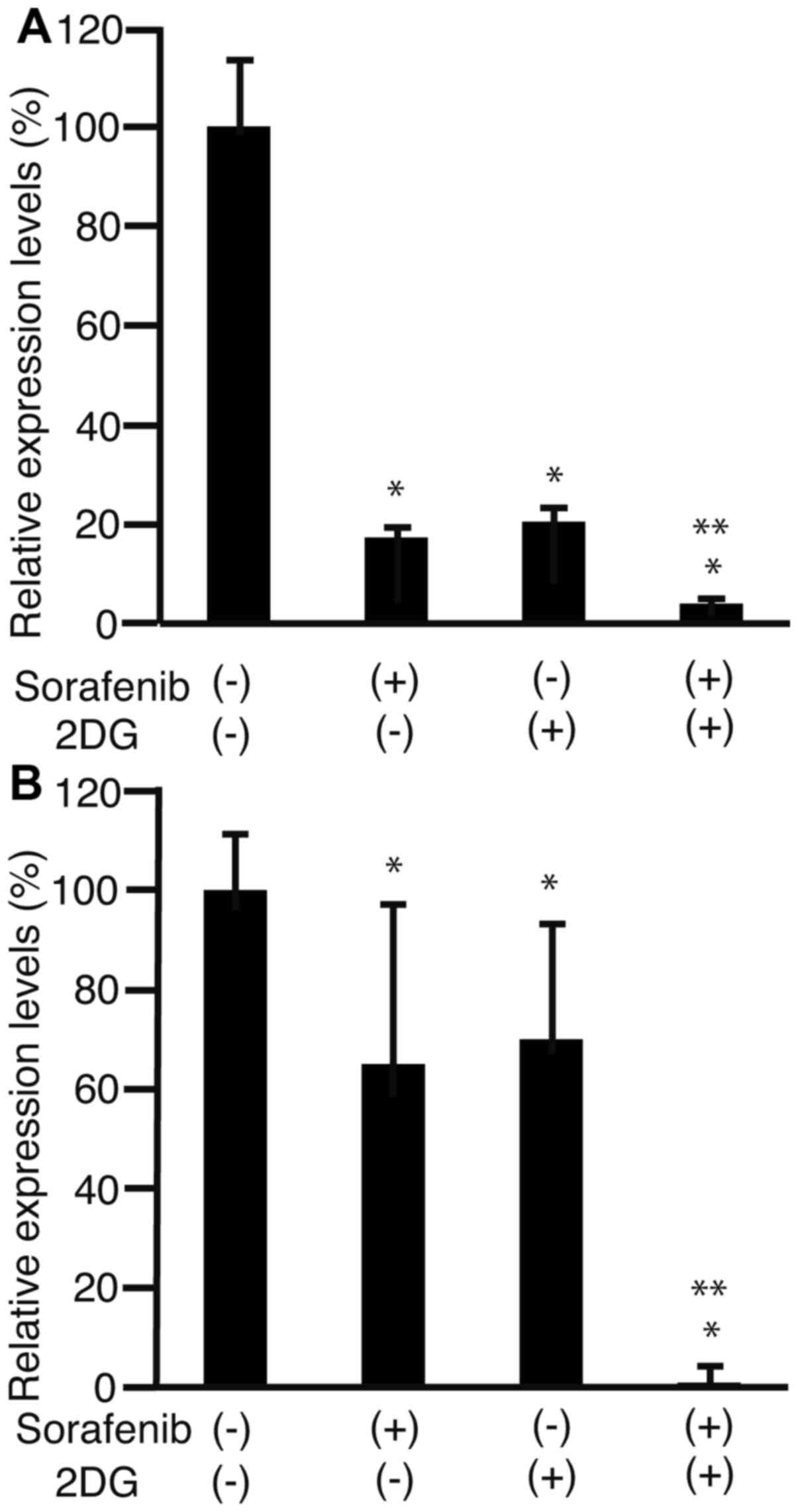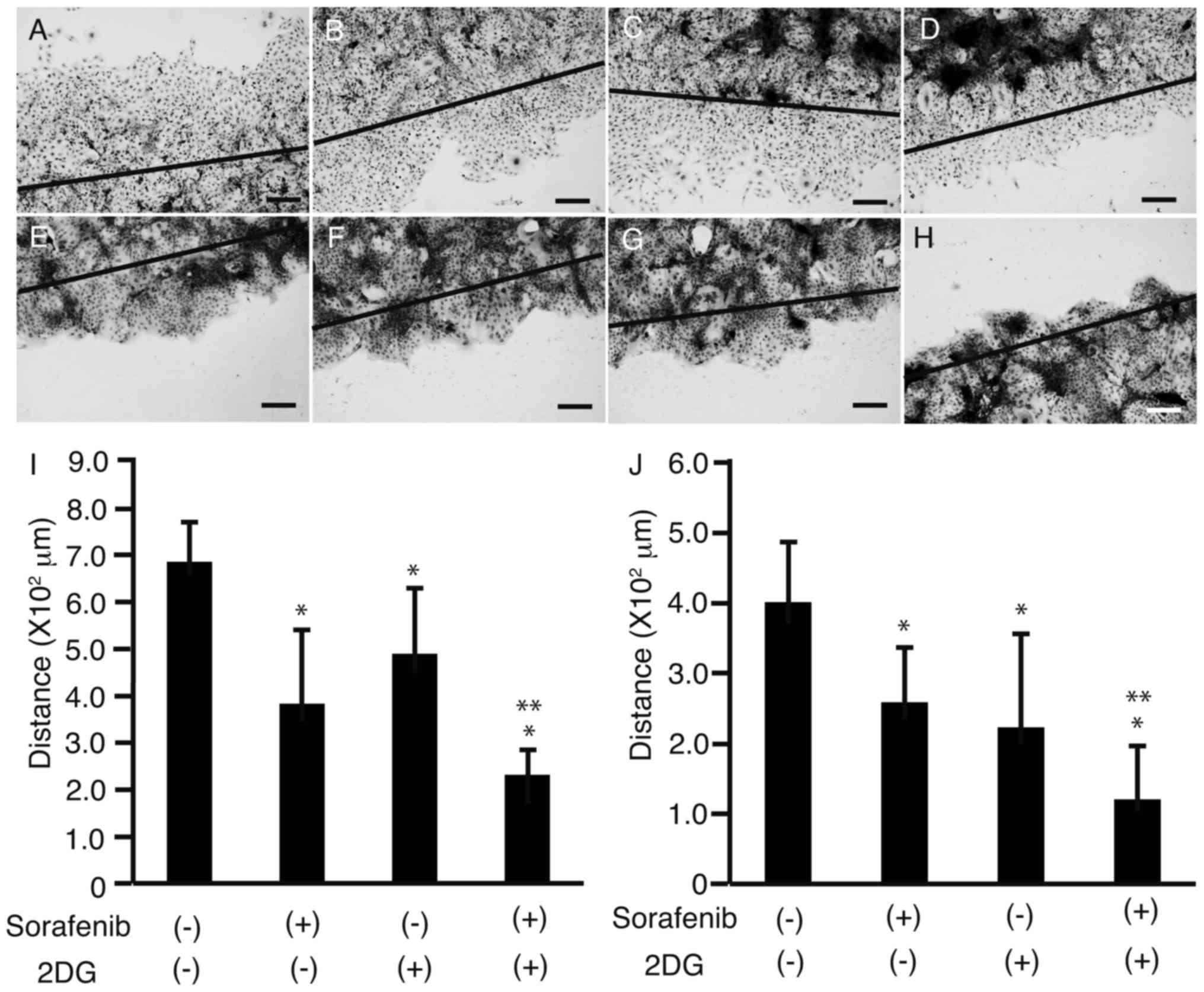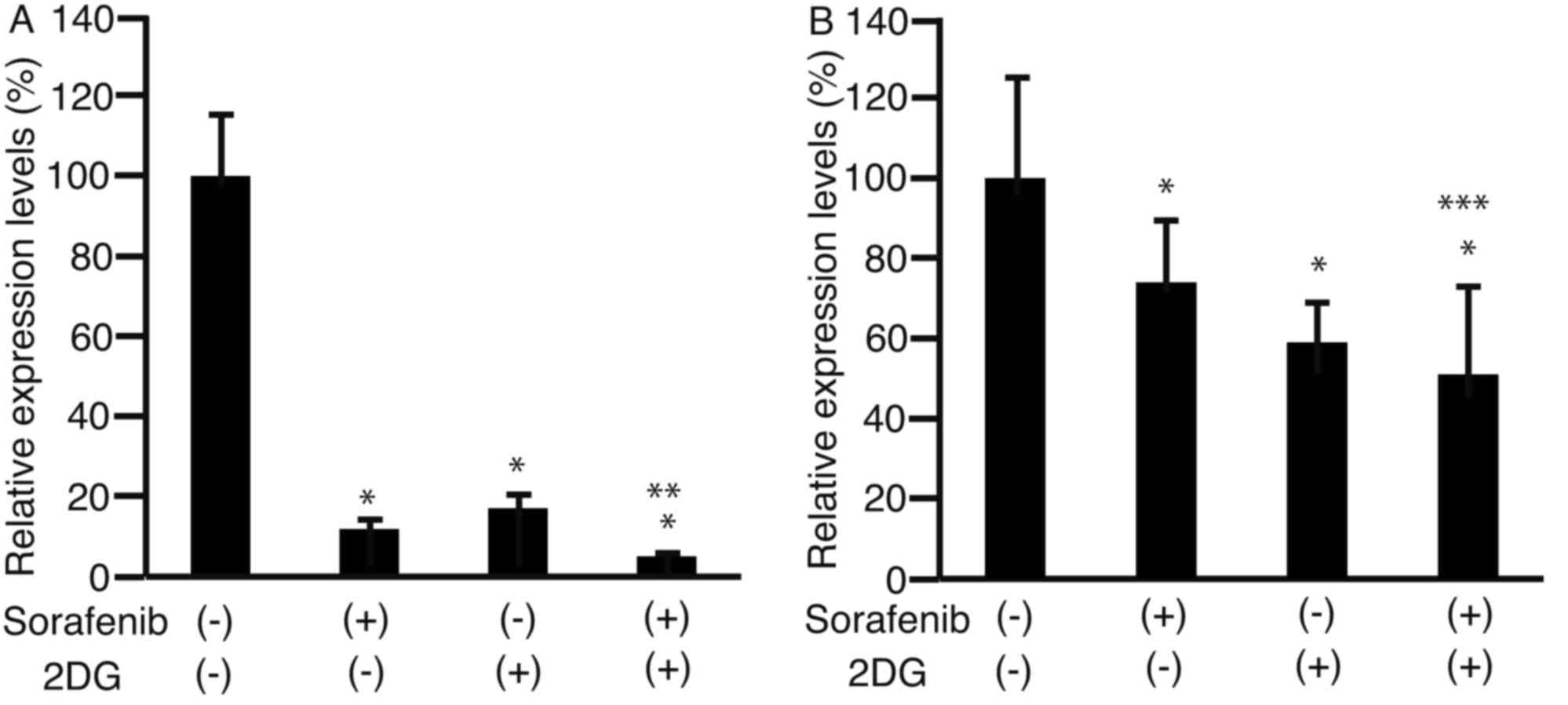2‑Deoxyglucose and sorafenib synergistically suppress the proliferation and motility of hepatocellular carcinoma cells
- Authors:
- Published online on: December 16, 2016 https://doi.org/10.3892/ol.2016.5510
- Pages: 800-804
Abstract
Introduction
Hepatocellular carcinoma (HCC) originates in the liver following long-term infection with the hepatitis B or C virus (1), and recent research has linked non-alcoholic steatohepatitis to HCC etiology (2). Current treatments include resection, local ablation, transcatheter arterial chemoembolization, targeted chemotherapy, and palliative care (3,4). In addition, sorafenib, a kinase inhibitor, is increasingly used to treat HCC (5), however there are problems associated with its use, most notably, the ability of HCC cells to develop resistance to it (6,7).
Cancer cells depend on glycolysis for energy production and survival, and they exhibit significantly higher rates of glycolysis than healthy tissues even when oxygen is plentiful, a phenomenon known as the Warburg effect (8). As they require more glucose than healthy tissue and metabolise this glucose primarily by glycolysis, inhibiting glycolysis may be a more effective way of eradicating cancer cells (9), and consequently be developed as a treatment for cancer (10).
2-Deoxy-d-glucose (2DG) is an analogue of glucose which cannot undergo glycolysis (11). Cancer cells take up 2DG in a similar way to glucose, however, they cannot metabolize it to produce energy. Therefore energy production is impaired, and cancer cells are damaged (11).
The safety of 2DG in humans has been established through its application in positron emission tomography (12). If the combination of sorafenib and 2DG exert significantly stronger anti-tumor effects than either drug alone, it may provide a novel therapeutic strategy to treat HCC.
The present study sought to investigate the suppressive effects of sorafenib and 2DG in combination on the proliferation and motility of HCC cells compared with sorafenib alone.
Materials and methods
Cells and cell culture
Human hepatocellula carcinoma cells, HLF cells and PLC/PRF/5 cells were purchased from the RIKEN BioResource Centre Cell Bank (Tsukuba, Japan), and cultured in Dulbecco's modified Eagle's medium (DMEM; Sigma-Aldrich, St. Louis, MO, USA) supplemented with 10% fetal bovine serum (FBS; Thermo Fisher Scientific, Inc., Waltham, MA, USA). The cells were cultured in 10 cm dishes (Asahi Techno Glass, Yoshida-cho, Japan) with 5% carbon dioxide at 37°C in a humidified chamber.
Cell proliferation assay
Cells were trypsinized, harvested, and split onto 96-well plates (Asahi Techno Glass) at a density of 1,000 cells/well. Varying concentrations of sorafenib (JS Research Chemicals Trading, Wedel, Germany), 0, 1, 3, 10, and 30 µM, were added to the media, and either 0 or 1 µM 2DG (Sigma-Aldrich) was added. Following 72 h culture, the cells were subjected to an MTS assay, (Promega Corporation, Madison, WI, USA) according to the manufacturer instructions. During the assay, the cells reduce MTS to a colored formazan product with an absorbance maximum at 490 nm. The absorbance of the product was subsequently measured using an iMark Microplate absorbance reader (Bio-Rad Laboratories Inc., Hercules, CA, USA).
Scratch assay
HLF and PLC/PRF/5 cells were plated on 4-well chamber slides (BD Biosciences, Franklin Lakes, NJ, USA), and scratched with a sterile razor when they reached confluence. Immediately after scratch, the cells were incubated for 48 h with 1 µM sorafenib, 3 µM 2DG, or a combination of both. Following incubation, they were stained with hematoxylin and eosin. The slides were observed under an AX80 microscope (Olympus Corporation, Tokyo, Japan, magnification ×100), and the distance between the scratched line and the growing edges of the cells was measured at five different points.
Reverse transcription-quantitative polymerase chain reaction (RT-qPCR)
Cells were cultured in 6-well plates (Asahi Techno Glass), and when they reached 70% confluence, were incubated with 1 µM sorafenib, 3 µM 2DG, or a combination of both. Following 48-h culture, RNA was isolated with Isogen (Nippon Gene Co., Tokyo, Japan) according to the manufacturer's instructions. The isolated RNA was suspended in autoclaved Tris-EDTA buffer (pH 8.0). Total RNA (5 µM) was subjected to cDNA synthesis with SuperScript III and oligo(dT) following manufacturer instructions (Thermo Fisher Scientific). RT-qPCR was performed using Fast SYBR Green Master Mix (Thermo Fisher Scientific) with Mini Opticon (Bio-Rad). RT-qPCR was performed for 40 cycles, with 5 sec of denaturation and 5 sec of annealing-extension. Primer sequences are presented in Table I. RPL19, a housekeeping gene that is constitutively expressed (13), was used as an internal control. The expression levels of gene were analyzed automatically by the Mini Opticon system (Bio-Rad) based on delta-delta cycle threshold (ddCt) method. Relative expression level of a gene was calculated as expression level of a gene divided by expression level of RPL19.
Statistical analysis
One-way analysis of variance (ANOVA) was used for statistical analysis with JMP software ver. 10.0.2 (SAS Institute, Cary, NC, USA). P<0.05 was considered to indicate a statistically significant difference.
Results
To investigate whether 2DG enhanced the anti-proliferative effects of sorafenib, HLF cells (Fig. 1A) and PLC/PRF/5 cells (Fig. 1B) were cultured with 0, 1, 3, 10, and 30 µM sorafenib either alone (black bars) or with 2DG (white bars). The combination of 1 µM 2DG and 30 µM sorafenib markedly suppressed cell proliferation of both cell types compared to sorafenib alone (P<0.05). This suggests that 2DG is able able to enhance the anti-proliferative effects of sorafenib in HLF and PLC/PRF/5 cells.
To clarify the effect of sorafenib and 2DG on the cell cycle, levels of cyclin D1 expression were analyzed by RT-qPCR in HLF cells (Fig. 2A) and PLC/PRF/5 cells (Fig. 2B). The expression of cyclin D1 in both cell types decreased more in cells exposed to sorafenib and 2DG compared with cells exposed to 2DG or sorafenib alone (P<0.05; Fig. 2). This demonstrates that sorafenib and 2DG together decrease cyclin D1 expression more effectively than either drug alone.
To investigate the effects of sorafenib and 2DG on cell motility, a scratch assay was performed on HLF cells (Fig. 3A-D) and PLC/PRF/5 cells (Fig. 3E-H). All cells were cultured in 4-well chamber slides, and following scratching with a sterile razor, 3 µM sorafenib (Fig. 3B and F), 1 µM 2DG (Fig. 3C and G), or a combination of both (Fig. 3D and H) were added. Cells were then stained, and the distance between the growing edge of the cell sheet and the scratched line was measured in HLF cells (Fig. 3I) and PLC/PRF/5 cells (Fig. 3J). The distance was shorter in cells cultured with both sorafenib and 2DG than in cells cultured with 2DG or sorafenib alone (P<0.05; Fig. 3I and J), suggesting that 2DG enhances the suppressive effects of sorafenib on cell motility.
Matrix metalloproteinase 9 (MMP9) is involved in cell motility and is overexpressed in HCC (14,15). MMP9 expression was analyzed using RT-qPCR in HLF cells (Fig. 4A) and PLC/PRF/5 cells (Fig. 4B), and was significantly lower in cells cultured with a combination of sorafenib and 2DG than in cells cultured with either drug alone (P<0.05).
Discussion
Previous studies have demonstrated that 2-[(3-Carboxy- 1-oxoprogy1) amino]-2-deoxy-D-glucose, another analogue of glucose similar to 2DG, suppresses the proliferation of cells from the human HCC HepG2 cell line (16). In the present study, 3 µM 2DG and 30 µM sorafenib significantly suppressed the proliferation of HLF and HCC PLC/PRF/5 cells. The difference in suppression of proliferation was significant at sorafenib concentrations >10 µM.
Sorafenib and 2DG independently decrease cyclin D1 expression (Fig. 2), therefore it was expected that the combination of sorafenib and 2DG would synergistically suppress HCC proliferation at lower concentrations of sorafenib. This was observed in both HLF and PLC/PRF/5 cells. However, the reasons underlying the suppressive effects of 2DG and sorafenib combination on HCC cell proliferation remain unclear.
Metastasis is a result of HCC cell invasion from the primary site to local or distant tissue (17). The combination of 2DG and sorafenib suppressed cell motility more effectively than 2DG or sorafenib alone (Fig. 3). Additionally, expression of MMP9 significantly decreased when cells were treated with a combination of 2DG and sorafenib compared with 2DG or sorafenib alone (Fig. 4), suggesting that treatment with both 2DG and sorafenib may effectively inhibit metastasis.
2DG enhances the anti-tumor effects of other chemotherapeutic agents (18). In vivo studies have demonstrated that sections of tumors are hypoxic (19), and cancer cells are resistant to 2DG in these hypoxic regions (20). The combination of 2DG and sorafenib offers a promising strategy to overcome this resistance.
The feasibility of this approach is contingent on 2DG and sorafenib being safe for oral administration. A combination of 2DG and docetaxel as treatment for solid cancers has been investigated, and no serious adverse effects were reported (21). Furthermore, a phase I/II clinical trial investigating the combination of radiotherapy and 2DG against glioma reported no serious adverse events (22). These reports and the results of the current study suggest that the combination of 2DG and sorafenib is safe for oral administration, though further studies are required to confirm this.
The main limitation of the present study was the lack of in vivo data from xenograft animal models, therefore future studies are required that investigate the effects of systemic 2DG and sorafenib administration in vivo.
In conclusion, the current study demonstrated that 2DG and sorafenib suppressed the proliferation of HCC cells more effectively than sorafenib alone, and suppressed cell motility more effectively than 2DG or sorafenib alone. Therefore, combined treatment of 2DG and sorafenib may be an effective therapeutic strategy to treat cancer, including HCC.
References
|
Cameron AM: Screening for viral hepatitis and hepatocellular cancer. Surg Clin North Am. 95:1013–1021. 2015. View Article : Google Scholar : PubMed/NCBI | |
|
Khan FZ, Perumpail RB, Wong RJ and Ahmed A: Advances in hepatocellular carcinoma: Nonalcoholic steatohepatitis-related hepatocellular carcinoma. World J Hepatol. 7:2155–2161. 2015. View Article : Google Scholar : PubMed/NCBI | |
|
Wells SA, Hinshaw JL, Lubner MG, Ziemlewicz TJ, Brace CL and Lee FT Jr: Liver ablation: Best practice. Radiol Clin North Am. 53:933–971. 2015. View Article : Google Scholar : PubMed/NCBI | |
|
Katano T, Mizoshita T, Senoo K, Sobue S, Takada H, Sakamoto T, Mochiduki H, Ozeki T, Kato A, Matsunami K, et al: The efficacy of transcatheter arterial embolization as the first-choice treatment after failure of endoscopic hemostasis and endoscopic treatment resistance factors. Dig Endosc. 24:364–369. 2012. View Article : Google Scholar : PubMed/NCBI | |
|
Furuse J, Ishii H, Nakachi K, Suzuki E, Shimizu S and Nakajima K: Phase I study of sorafenib in Japanese patients with hepatocellular carcinoma. Cancer Sci. 99:159–165. 2008.PubMed/NCBI | |
|
Kuczynski EA, Lee CR, Man S, Chen E and Kerbel RS: Effects of sorafenib dose on acquired reversible resistance and toxicity in hepatocellular carcinoma. Cancer Res. 75:2510–2519. 2015. View Article : Google Scholar : PubMed/NCBI | |
|
Chen J, Jin R, Zhao J, Liu J, Ying H, Yan H, Zhou S, Liang Y, Huang D, Liang X, et al: Potential molecular, cellular and microenvironmental mechanism of sorafenib resistance in hepatocellular carcinoma. Cancer Lett. 367:1–11. 2015. View Article : Google Scholar : PubMed/NCBI | |
|
Vaitheesvaran B, Xu J, Yee J, Qy L, Go VL, Xiao GG and Lee WN: The Warburg effect: A balance of flux analysis. Metabolomics. 11:787–796. 2015. View Article : Google Scholar : PubMed/NCBI | |
|
Jang M, Kim SS and Lee J: Cancer cell metabolism: Implications for therapeutic targets. Exp Mol Med. 45:e452013. View Article : Google Scholar : PubMed/NCBI | |
|
Granja S, Pinheiro C, Reis RM, Martinho O and Baltazar F: Glucose addiction in cancer therapy: Advances and drawbacks. Curr Drug Metab. 16:221–242. 2015. View Article : Google Scholar : PubMed/NCBI | |
|
Zhang D, Li J, Wang F, Hu J, Wang S and Sun Y: 2-Deoxy- D-glucose targeting of glucose metabolism in cancer cells as a potential therapy. Cancer Lett. 355:176–183. 2014. View Article : Google Scholar : PubMed/NCBI | |
|
Brito AF, Mendes M, Abrantes AM, Tralhão JG and Botelho MF: Positron emission tomography diagnostic imaging in multidrug-resistant hepatocellular carcinoma: Focus on 2-deoxy-2-(18F)Fluoro-D-Glucose. Mol Diagn Ther. 18:495–504. 2014. View Article : Google Scholar : PubMed/NCBI | |
|
Davies B and Fried M: The L19 ribosomal protein gene (RPL19): Gene organization, chromosomal mapping, and novel promoter region. Genomics. 25:372–380. 1995. View Article : Google Scholar : PubMed/NCBI | |
|
Vandooren J, Van den Steen PE and Opdenakker G: Biochemistry and molecular biology of gelatinase B or matrix metalloproteinase-9 (MMP-9): The next decade. Crit Rev Biochem Mol Biol. 48:222–272. 2013. View Article : Google Scholar : PubMed/NCBI | |
|
Zhang Y, Shen Y, Cao B, Yan A and Ji H: Elevated expression levels of androgen receptors and matrix metalloproteinase-2 and −9 in 30 cases of hepatocellular carcinoma compared with adjacent tissues as predictors of cancer invasion and staging. Exp Ther Med. 9:905–908. 2015.PubMed/NCBI | |
|
Wu J, Kou W, Gao MT, Zhou YN, Wang AQ, Xue QJ and Qiao L: Effects of {2-[(3-carboxy-1-oxoprogy1)amino]-2-deoxy-D-glucose} on human hepatocellular carcinoma cell line. Acta Pharmacol Sin. 26:635–640. 2005. View Article : Google Scholar : PubMed/NCBI | |
|
Tomizawa M, Kondo F and Kondo Y: Growth patterns and interstitial invasion of small hepatocellular carcinoma. Pathol Int. 45:352–358. 1995. View Article : Google Scholar : PubMed/NCBI | |
|
Takemura A, Che XF, Tabuchi T, Moriya S, Miyazawa K and Tomoda A: Enhancement of cytotoxic and pro-apoptotic effects of 2-aminophenoxazine-3-one on the rat hepatocellular carcinoma cell line dRLh-84, the human hepatocellular carcinoma cell line HepG2, and the rat normal hepatocellular cell line RLN-10 in combination with 2-deoxy-D-glucose. Oncol Rep. 27:347–355. 2012.PubMed/NCBI | |
|
Lv Y, Zhao S, Han J, Zheng L, Yang Z and Zhao L: Hypoxia-inducible factor-1α induces multidrug resistance protein in colon cancer. Onco Targets Ther. 8:1941–1948. 2015. View Article : Google Scholar : PubMed/NCBI | |
|
Maher JC, Wangpaichitr M, Savaraj N, Kurtoglu M and Lampidis TJ: Hypoxia-inducible factor-1 confers resistance to the glycolytic inhibitor 2-deoxy-D-glucose. Mol Cancer Ther. 6:732–741. 2007. View Article : Google Scholar : PubMed/NCBI | |
|
Raez LE, Papadopoulos K, Ricart AD, Chiorean EG, Dipaola RS, Stein MN, Lima CM Rocha, Schlesselman JJ, Tolba K, Langmuir VK, et al: A phase I dose-escalation trial of 2-deoxy-D-glucose alone or combined with docetaxel in patients with advanced solid tumors. Cancer Chemother Pharmacol. 71:523–530. 2013. View Article : Google Scholar : PubMed/NCBI | |
|
Singh D, Banerji AK, Dwarakanath BS, Tripathi RP, Gupta JP, Mathew TL, Ravindranath T and Jain V: Optimizing cancer radiotherapy with 2-deoxy-d-glucose dose escalation studies in patients with glioblastoma multiforme. Strahlenther Onkol. 181:507–514. 2005. View Article : Google Scholar : PubMed/NCBI |













